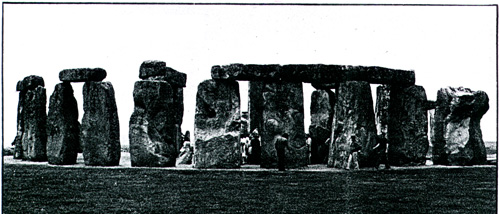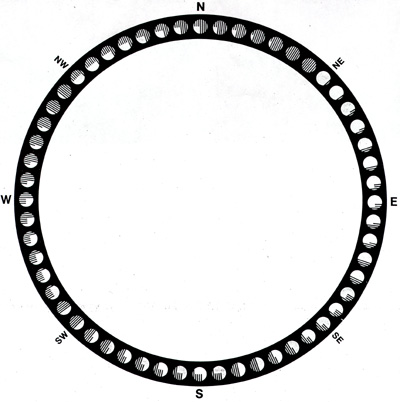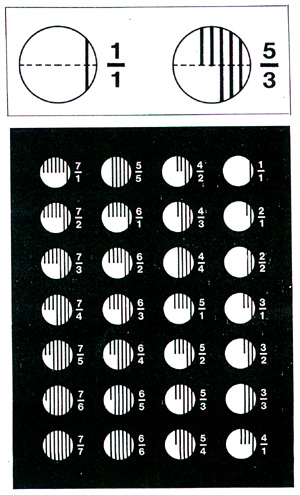

New Hampshire Times - July 6, 1977 - page 21

A certain way to expand the horizons of mind and imagination is to talk with Bart Jordan of Durham. His work of deciphering the symbols of ancient peoples unlocks fascinating possibilities about our distant past. His interpretation of the earliest use for Stonehenge, the monumental Bronze Age structure in England, is no less intriguing.
As partly discussed in the article "Roots" (New Hampshire Times 1-12-77), Jordan found through his research that a worldwide observance of the 28-night cycle of the moon and the average 28-night menstrual cycle of women was incorporated into a lunar-menstrual tradition with ritualistic symbols and artifacts dating 30,000 years ago, perhaps more.
The number 28 was no less significant, Jordan maintains, for the circle of 56 chalk-filled holes at Stonehenge. This is the first time that his solution to the long-standing mystery concerning the 56 holes has been printed.
In our modern world, where food is produced in laboratories and human beings are grown in test tubes, our ultimate, undeniable relationship with the pervasiveness of nature is shielded by a technologically-nurtured delusion of grandeur. Yet no matter what masks we wear, we are ineluctably of nature.
The ancients did not forget this relationship with nature. They recognized the vital correlations between cosmic cycles and human cycles. They honored these correlations for the human dependence on nature that the cycles represented. They enshrined the correlations by setting up their calendars in accord with the cycles.
The lunar-menstrual cycle is one such example that was sewn into the fabric of thought passed from generation to generation and from culture to culture. Perhaps no other cycle was and is more integrated into everyday life than that of the lunar-menstrual month or 28 nights of the "common law" month.
In ancient Peru (as in both ancient and modern China or India), calendar months were primarily based on the 28-night lunar-menstrual period, not on the deviating 30 or 31-day periods associated with the solar year. Paul Kosok, in his book "Life, Land, and Water in Ancient Peru," wrote: "The significance of our find was that it (a Nazca Indian textile) represented a 28-day month, and a 13-month year, thus producing a 364-day year."
The Big Horn Medicine Wheel in Wyoming appears to be another example of the significance of the number 28. The Wheel is a circle of stones 25 meters in diameter and has 28 irregularly spaced stone spokes emanating from a central cairn. It is located at 9,640 feet elevation, above timberline.
The Medicine Wheel is calculated to have been constructed 200 years ago, much before the white men discovered it in the 19th century. The 28-spoked Medicine Wheel and its cairns have been interpreted by present-day astronomer John Eddy as a site that marks the sunrise and sunset of the summer solstice plus the risings of certain stars. Jordan feels that the 28 spokes appear to make ritualistic reference to the lunar-menstrual month of 28 nights.
To Eddy, Jordan, and others, the 28 spokes make it virtually identical in concept to the Sun Dance Lodge of the Sioux. In "The Sacred Pipe: Black Elk's Account of the Seven Rites of the Oglala Sioux," the importance of the number 28 is underscored and demonstrated.
The Sun Dance Lodge was constructed of 28 forked sticks radiating from the holy tree of life, from Wankan-Tanka, the center and source of all. To the Sioux, their Sun Dance Lodge represented the whole of the universe.
Black Elk tells us that four and seven were sacred numbers to the Sioux. If four sevens were added, the sacred number 28 results. Black Elk says: "You should also know that the buffalo has 28 ribs, and that in our war bonnets we usually have 28 feath- ers. You see, there is a significance for everything, and these are the things that are good for men to know, and to remember."
From continent to continent, the revered lunar- menstrual tradition was patterned into ordinary life. In England the use of the sennight (seven nights), fortnight (14 nights), 28-night month, and 13-month year belonging to the ancient lunar-menstrual tradi- tion was sustained. This figuring of time was in com- mon use until the 14th century, as is shown by "The Ballad of Robin Hood and the Curtal Friar:"
But how many merry months be in the yeare?
There are thirteen, I say;
The midsummer moon is the merryest of all,
Next to the merry month of May.
The "common law" month in England derived from the lunar-menstrual month of 28 nights. Edward Coke, the English jurist, wrote in 1628 that, "A month mensis is regularly accounted in Law 28 dayes, and not according to the Solar month, nor ac- cording to the Kalendar."
William Blackstone in 1766 defined the "common law" month in his Commentaries as follows: "A month in law is a lunar month, or 28 days, unless otherwise expressed." A true lunar month, full moon to full moon, requires 29.53 days. The lunar month then is defined by Blackstone in terms of the lunar- menstrual month, reflecting the union of cosmic and human cycles.
Bart Jordan maintains that the Englanders who built Stonehenge strove to keep faith with the earliest form of calendar that used the 13-month year of 28-night months. This calendar, Jordan believes, provided the primary reason for the 56 Aubrey holes at Stonehenge.

"Surrounding the stonework are the Aubrey holes," Jordan said. "The holes have been a mystery ever since John Aubrey uncovered them in the 1660s. They belong to Stonehenge I. In other words, apart from the huge Heel Stone located in the northeast, the stonework with which we are all familiar was not even there."
In "Stonehenge Decoded," author Gerald Hawkins writes that the 56 Aubrey holes pose "a most difficult problem." Almost immediately after they were dug, they were filled with white chalk. They never held stones or posts, and were used only now and then for cremations. They were dug at intervals so precisely spaced that they could never have been used to "mark the Sun, Moon, or any other celestial object."
The spacings of the 56 Aubrey holes were dug at an error of less than 0.5 degrees of azimuth throughout the entire circle.
"There's no question about that spacing arrangement," Jordan said. "When there's equal spacing like that, it's for one purpose only and that is to commemorate something which is that steady and able to be marked and that doesn't depend on horizon lines or any other sighting device astronomically. That something, I believe, is night and day."
Hawkins, however, relating the holes to the later standing stones, writes: "1 believe that the 56 Aubrey holes served as a computer. If one stone was moved around the circle one position, or Aubrey hole, each year, all extremes of the seasonal moon, and eclipses of the sun and the moon at the solstices and equifoxes, could have been foreseen."
This conjecture was based initially on Hawkins' finding that when a person stands in the center of the circle, the sun, the moon, and certain stars appear over certain stones often enough to rule out pure coincidence. The moon produces the most significant eclipse cycles when every 18.61 years it rises in mid- winter over a certain stone.
For Hawkins, the 56 Aubrey holes served as receptacles for stones which marked eclipse cycles and other celestial phenomena throughout a 56-year span. The moon, for example, requires 18.61 years to com- plete one eclipse cycle. As Hawkins says, "After 56 years, the sequence of eclipse seasons returns to within three or four days of the starting point of the Gregorian calendar."
Jordan says that Hawkins is correct about the possible use of the Aubrey holes in predicting eclipses over a 56-year period. However, Jordan asks, if the 56 equally-spaced holes were not of themselves any use in marking heavenly objects, as Hawkins says, what was their original purpose prior to the erection of the standing stones, which followed hundreds of years after the Aubrey holes were constructed?
"I don't differ with Hawkins' 56-year cycle theory on an astronomical basis," Jordan said. "But I do maintain that it's far more likely the 56 Aubrey holes were there as a day-night series.
Jordan figures that the 56 holes were alternately filled with yellow and white-chalk to represent the sun and the moon. Two holes, yellow and white, were considered as a unit or pair, representing the daytime and nighttime of a given day in the lunar- menstrual cycle or "common law" month of 28 days.
"The point is that this would give you twice 28, which equals 56," he said. "You would then have a series representing 28 of something, not 56 of something. Regardless of what Hawkins' readings are in connection with the idea of the 56-year cycle, we still have to contend with the problem of what occurred before those stone uprights. It would seem to me that, in view of the tremendously powerful evidence that exists throughout many areas of the world, twice 28 represented the lunar-menstrual month."
Basically, Jordan thinks that Hawkins does not go back far enough to explain the meaning of the 56 holes, only their function centuries later. "Ideas that belong to a structure can change," Jordan said, "and that clearly is the case with Stonehenge."
For Jordan, the 56 Aubrey holes originally provided for equal representation of the sun of day and the moon of night of the "common law" month. To him, the ancient Englanders created out of Mother Earth their powerfully ritualistic site, immortalizing the 28 days and nights of the lunar-menstrual period. "And what is so beautifully human about the site," he said, "is the way in which the earthwork was set up to appear as a giant womb with the great Heel Stone to the northeast standing erect beside the opening."
After a visit to Stonehenge 20 years ago, Jordan wrote a number of scholars about his ideas concerning the site. At the time, he said, his theories were considered to be "out in left field, if not entirely out of the ballpark.
"I didn't have anything but my thinking to document my point," he said. "Today it's a different story. I'm armed with the knowledge that 28, the average menstrual cycle, was observed ritualistically throughout the world. It's also linguistically so, powerfully represented in English itself, more than in any other European language. I'm forced back to my original position that the people of the British Isles who built this earthwork and stone monument work, because that's what they were--two different works-- were in all likelihood very eclectic."
Jordan has talked with Hawkins, who lives in Wellesley Hills, Mass., about the Aubrey holes. "He feels that there is a likelihood that I've hit upon the right solution," Jordan said.
At 4,000 years old, Stonehenge enshrines the oldest known calendar system in the history of the world, even though the average menstrual cycle has been known for certain for 30,000 years. For those who still say that the ancient peoples could not have produced such a feat, Jordan answers, "Our 20th century view is extraordinarily pompous and arrogant with regard to the intellect. We feel ourselves to be the greatest thing created under God, and sometimes we even think we're a day older than Him. I think that's a great mistake."
Jordan feels that we should look well behind Stonehenge to see how the 56 Aubrey holes might have been differentiated from one another beyond simply the yellow of day and the white of night. He speculates that the chalk-filled holes once carried the working result of a lunar-menstrual notation that he reconstructed from Plutarch and which he believes was developed long before Stonehenge. Each number symbol is read as if the circle containing it were cut in half, giving an upper number and a lower number:

He further speculates that heavily blackened logs, treated with something to withstand rain, were placed in paired number patterns from 1/1 to 7/7 across the yellow and white chalk-filled holes. These blackened logs, beginning in the northeast adjacent to the Heel Stone, were placed progressively across all 56 holes to ritually mark the turning of the 28 days and 28 nights of the lunar-menstrual cycle.
"It's the only lunar-menstrual notation that could be set out in a circle because all the other notations have to be set out in a square where their four ranks of seven individual characters can maintain their directional integrity," Jordan said. "Rotating within a square, the seven individual characters must first face east for east week, next face south for south week, then face west for west week, and lastly face north for north week. By contrast, the permutated numerical notation presented here can be read from any direction because the specific permutated number within each given circle or pair of circles is wholly unique."
Is he certain of assigning his notation to the Aubrey holes? "In decipherment," Jordan said, "especially cultural decipherment, there are few absolutes of the moment, and fewer still of eternity. Nonetheless, were one going to develop a permutated notation from 1/1 to 7/7, this is the only mathematical method by which it could be done. If one then wanted to set the notation out in a circle with equal spacings of azimuth, this is the only graphic method by which it could be done. If the circle of 56 Aubrey holes represents what it appears to represent with respect to the lunar-menstrual month of 28 days and 28 nights, then this permutated notation is the only notation the circle of holes was meant to hold. There is no other."
As far as the interpretation of the most puzzling mystery of Stonehenge is concerned--the Aubrey holes--the question in its basic form revolves around whether the holes represent 56 of something or twice 28 of something. For Bart Jordan of Durham, the Aubrey holes do not represent a complicated system of eclipses over a 56-year cycle. For him, the 56 Aubrey holes represent the logical simplicity of twice 28, a day and night system used by the people of Upper Paleolithic culture to honor the intimate correlations they perceived between the cycles of human- kind and the cycles of nature.
by Steve Sherman
photo by Bob LaPree